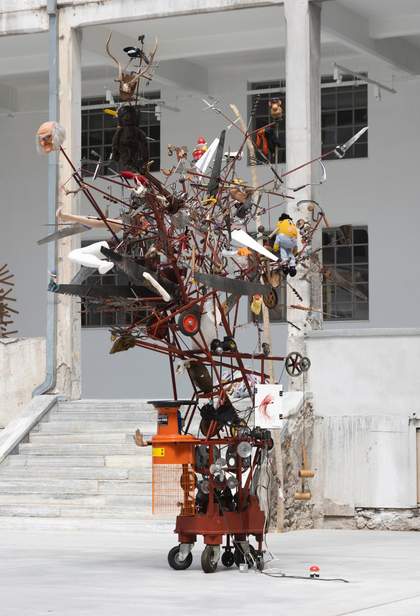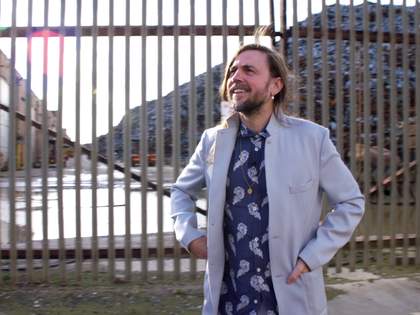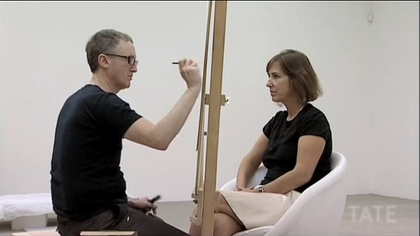Lawrence Sillars:
I’m Lawrence Sillars. I’m the curator at Tate Liverpool, and I’m working with the artist Michael Landy at the moment, and together we’re curating the exhibition, ‘Joyous Machines’, which is a celebration of both Michael’s work and his relationship to Jean Tinguely.
Michael Landy:
This reminds me of when I was making scrap heap surfaces, I used to collect all this junk from McDonald's. I used to go and raid McDonald's late at night and get all the wrappers, and of course I’d leave it in my Golf Sierra overnight, and a whole, like, ecosystem would have fermented overnight, and it really did stink!
Lawrence Sillars:
Michael Landy’s perhaps best known for his work Breakdown made in 2001, which was the end of a three year process when he catalogued each and every one of his worldly possessions and then destroyed them all, reduced everything he owned to dust in full view of the public.
Michael Landy:
It does make you feel, doesn’t it, feel guilty, because you start thinking about all the things I’ve thrown out that actually could have had another life. I was so mean for other people to get my things, that I’d rather throw them away. I also – you know what – I don’t like Marks. I don’t mean Mark Wallinger. I meant just marks on things. Marks and Spencer, Karl Marx, Groucho…
Lawrence Sillars:
Michael and I have come to this recycling facility in Kentish Town to look through the junk, to rummage through what people have thrown away, just as Jean Tinguely did about 50 years ago before he was going to make Homage to New York, his massive self-destroying sculpture.
Michael Landy:
It really is like big boys, big toys, isn’t it?
Lawrence Sillars:
John Tinguely was a Swiss sculptor, and he was one of the most radical and subversive sculptors of the mid-twentieth century. He made an incredible array of machines that did weird and wonderful things, from smashing full beer bottles in a gallery to creating endless series of abstract drawings. And he’s an artist that really was a great influence on Michael Landy. And Michael went to see an exhibition of his at the Tate Gallery, now Tate Britain, in 1982, and was blown away by what he saw.
Michael Landy:
I mean, when I first entered the Tate Gallery in 1982, his sculptures were just kind of dance, a pogo, you know, jumping up and down, they weren’t working, they were… I mean, it was just so full of life, really, and that’s what I mean. And a student at that point, our kind of concerns were about broaching the gap between art and the public, and everybody was smiling, and really using the machines and making drawings and making paintings and throwing balls in machines. And people were just really enjoying it, like in a fairground, in a way. And I don’t see anything wrong with that. But it was at the Tate Gallery, and I thought that was really incredible. So I think that had a massive impression on me as a student.
Well, I started destroying things at an early age. I destroyed all my mum’s Beatles collection when I was a child. I think it all started from there, really! But no… there is a great pleasure in taking things apart and seeing how things are made. Because obviously you become more aware how things are… you know, the shiny surfaces, and the way things look. But once you start to literally take things apart, you can see how well it’s been made or how badly it’s been made, and suddenly you understand things a lot more, in a way. And obviously being an artist I aestheticise things as well.
Lawrence Sillars:
I was going to ask you about Homage to New York and your recreation of it. And Tinguely obviously worked with Billy Kluver, who was an electrical engineer, who was incredibly methodical and scientific about everything, and wanted to make the whole construction unfold as a sequential narrative. But of course it all went totally wrong, and all the bits didn’t function correctly, and this machine that was invented and created to destroy itself, failed to destroy itself, and it caught fire and had to be extinguished and brought under control by the fire brigade. If you did a recreation, would you want to polish it off as Tinguely had intended to, or would you…?
Michael Landy:
Yeah, I would like to… well, the thing was, because obviously it didn’t destroy itself, and so, you know, a lot of people stood around in the freezing cold of 17 March1960 – freezing – and they were waiting for something to happen, and nothing really did happen until the New York Fire Brigade put it out of its misery and pulled it all down, made it into ruins, and people took bits away with them. So, I mean, I’d still like to make it one day. I don’t know when. And hopefully I will. It’s the kind of… as long as I still exist, then I’d still like to make it.








